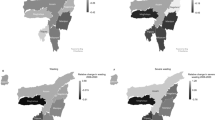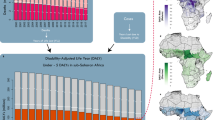Abstract
Background/Objectives:
Zinc is an essential micronutrient and deficiency can lead to an increased risk for infectious diseases and growth retardation among children under 5 years of age. We aimed to estimate disease-specific and all-cause mortality attributable to zinc deficiency.
Subject/Methods:
We estimated the prevalence of zinc deficiency in Latin America, Africa and Asia, where based on zinc availability in the diet and childhood stunting rates, zinc deficiency is widespread. The relative risks of death among zinc-deficient children for diarrhea, malaria and pneumonia were estimated from randomized controlled trials. We used the comparative risk assessment methods to calculate deaths and burden of disease (measured in disability-adjusted life years, DALYs) from each of these three diseases attributable to zinc deficiency in these regions.
Results:
Zinc deficiency was responsible for 453 207 deaths (4.4% of childhood deaths), and 1.2% of the burden of disease (3.8% among children between 6 months and 5 years) in these three regions in 2004. Of these deaths, 260 502 were in Africa, 182 546 in Asia and 10 159 in Latin America. Zinc deficiency accounted for 14.4% of diarrhea deaths, 10.4% of malaria deaths and 6.7% of pneumonia deaths among children between 6 months and 5 years of age.
Conclusions:
Zinc deficiency contributes to substantial morbidity and mortality, especially from diarrhea. Zinc supplementation provided as an adjunct treatment for diarrhea may be the best way to target children most at risk of deficiency.
This is a preview of subscription content, access via your institution
Access options
Subscribe to this journal
Receive 12 print issues and online access
$259.00 per year
only $21.58 per issue
Buy this article
- Purchase on Springer Link
- Instant access to full article PDF
Prices may be subject to local taxes which are calculated during checkout
Similar content being viewed by others
References
Aggarwal R, Sentz J, Miller MA (2007). Role of zinc administration in prevention of childhood diarrhea and respiratory illnesses: a meta-analysis. Pediatrics 119, 1120–1130.
Brooks WA, Santosham M, Naheed A, Goswami D, Wahed MA, Faruque AS et al. (2005). Weekly zinc supplements prevent pneumonia and reduce mortality in children less than two years in a Dhaka urban low-income population: a randomized controlled trial. Lancet 366, 999–1004.
Brown KH, Rivera JA, Bhutta Z, Gibson RA, King JC, Lonnerdal B et al. (2004). Assessment of the risk of zinc deficiency in populations. Food Nutr Bull 25, S130–S162.
Caulfield LE, Black RE (2004). Zinc deficiency. In: Ezzati M, Lopez AD, Rodgers A, Murray CJL (eds). Comparative Quantification of Health Risks: Global and Regional Burden of Disease Attributable to Selected Major Risk Factors. World Health Organization: Geneva. pp 257–279.
Ezzati M, Lopez AD, Rodgers A, Murray CJL (eds) (2004). Comparative Quantification of Health Risks: The Global and Regional Burden of Disease Attributable to Selected Major Risk Factors (vols. 1 and 2). World Health Organization: Geneva.
Ezzati M, Lopez AD, Rodgers A, Vander Hoorn S, Murray CJL . tCRAC Group (2002). Selected major risk factors and global and regional burden of disease. Lancet 360, 1347–1360.
Fischer Walker CLF, Black RE (2007). Functional indicators for assessing zinc deficiency. Food Nutr Bull 28, S454–S479.
Hambidge M (2000). Human zinc deficiency. J Nutr 130, 1344S–1349S.
Hess SY, Peerson JM, King JC, Brown KH (2007). Use of serum zinc concentration as an indicator of population zinc status. Food Nutr Bull 28, S403–S429.
Lopez AD, Mathers CD, Ezzati M, Jamison DT, Murray CJL (eds) (2006). Global Burden of Disease and Risk Factors. Oxford University Press: New York.
Muller O, Becher H, van Zweeden AB, Ye Y, Diallo DA, Konate AT et al. (2001). Effect of zinc supplementation on malaria and other causes of morbidity in West African children: randomised double blind placebo controlled trial. BMJ 322, 1567.
Prasad AS, Miale A, Farid Z, Sanstead HH, Schulert AR, Darby WJ (1963). Biochemical studies on dwarfism, hypogonadism and anemia. Arch Internal Med 111, 407–428.
Sazawal S, Black RE, Menon VP, Dinghra P, Caulfield LE, Dhingra U et al. (2001). Zinc supplementation in infants born small for gestational age reduces mortality: a prospective, randomized, controlled trial. Pediatrics 108, 1280–1286.
Sazawal S, Black RE, Ramsan M, Chwaya HM, Dutta A, Dhingra U et al. (2007). Effects of zinc supplementation or mortality in children 1–48 months of age: a community-based randomized placebo-controlled trial. Lancet 369, 927–934.
Sur D, Gupta DN, Mondal SK, Ghosh S, Manna B, Rajendran K et al. (2003). Impact of zinc supplementation on diarrheal morbidity and growth pattern of low birth weight infants in Kolkata, India: a randomized, double-blind, placebo-controlled, community-based study. Pediatrics 112, 1327–1332.
Tielsch JM, Khartry SK, Stoltzfus RJ, Katz J, LeClerq SC, Adhikari RK et al. (2007). Effect of daily zinc supplementation on child mortality in southern Nepal: a community-based, cluster randomized, placebo-controlled trial. Lancet 370, 1230–1239.
Van Wouwe JP (1995). Clinical and laboratory assessment of zinc deficiency in Dutch children. A review. Biol Trace Elem Res 49, 211–225.
WHO (1996). Zinc. Trace Elements in Human Nutrition and Health. WHO: Geneva.
WHO, UNICEF (2004). WHO–UNICEF Joint Statement on the Clinical Management of Acute Diarrhea. World Health Assembly: Geneva.
Acknowledgements
We acknowledge Juan Rivera for assistance in classifying the countries according to risk of zinc deficiency, Colin Mathers for the GBD estimates of mortality and burden of disease, Rodrigo Dias for his assistance in calculating the disease burden attributable to zinc deficiency and Sunil Sazawal for assistance in calculating the cause-specific RRs of death. This study was funded by grants from the Bill and Melinda Gates Foundation for the Development of the Maternal and Child Undernutrition Series and for the Zinc Task Force. Additional funding was provided by the Johns Hopkins Global Research Activity funded by the United States Agency for International Development.
Author information
Authors and Affiliations
Corresponding author
Additional information
Contributors: CLFW wrote the initial draft of the manuscript. REB conceptualized and assisted with the analyses. ME calculated the disease burden attributable to zinc deficiency. All authors contributed to the final manuscript.
Conflict of interest
The authors have no competing interests.
Rights and permissions
About this article
Cite this article
Fischer Walker, C., Ezzati, M. & Black, R. Global and regional child mortality and burden of disease attributable to zinc deficiency. Eur J Clin Nutr 63, 591–597 (2009). https://doi.org/10.1038/ejcn.2008.9
Received:
Revised:
Accepted:
Published:
Issue Date:
DOI: https://doi.org/10.1038/ejcn.2008.9
Keywords
This article is cited by
-
Zinc status in public health: exploring emerging research trends through bibliometric analysis of the historical context from 1978 to 2022
Environmental Science and Pollution Research (2023)
-
Gender, nutritional disparities, and child survival in Nepal
BMC Nutrition (2022)
-
Predictors of Breast Milk Zinc Levels Among Breastfeeding Women in Palestine: a Cross-Sectional Study
Biological Trace Element Research (2022)



